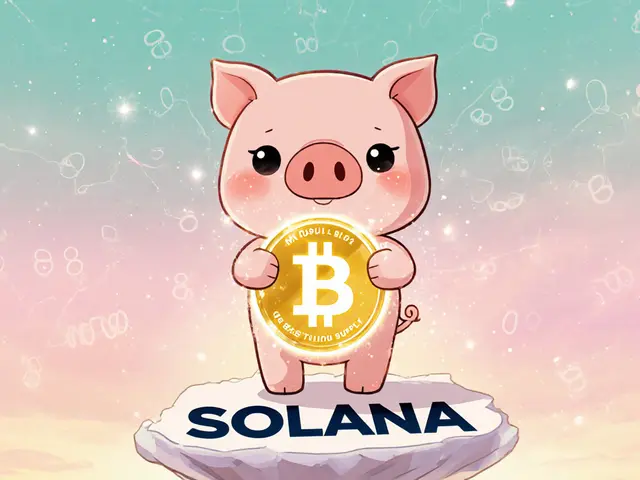Uniswap v3 (Celo) vs Ethereum Comparison Tool
Celo Uniswap v3
Assets: 28
Pairs: 55
Fee Tiers: 0.01% - 1%
Ethereum Uniswap v3
Assets: ~120
Pairs: ~2,500
Fee Tiers: 0.01% - 1%
Compare Key Metrics
Comparison Results
Enter values above and click "Compare Metrics" to see detailed analysis.
Looking for a no‑middle‑man way to swap stablecoins on a network built for emerging markets? Uniswap v3 Celo promises exactly that - a permissionless, non‑custodial exchange that lives on the fast, low‑fee Celo blockchain. This review breaks down what the platform offers, who it’s best for, and what pitfalls to watch out for in 2025.
Key Takeaways
- Uniswap v3 (Celo) runs on a specialized deployment of Uniswapv3, optimized for Celo’s low‑fee, mobile‑first architecture.
- It focuses on stablecoin pairs, with USDT/USDC generating over $3.4M in 24‑hour volume.
- Liquidity providers can use concentrated liquidity and three fee tiers (0.01%‑1%).
- Token selection is limited - 28 assets across ~55 pairs - compared with >100 on Ethereum.
- Growth is explosive: 5,680% volume jump from 2023 to 2024, but regulatory gray area remains.
What Is Uniswap v3 (Celo)?
Uniswap v3 (Celo) is a decentralized exchange (DEX) that implements the third‑generation automated market maker (AMM) protocol on the Celo blockchain. Launched in July2022, the platform lets users swap cryptocurrencies directly from their wallets without any custodial holding. It’s built for low‑cost, mobile‑centric transactions, making it attractive for users in Africa, Southeast Asia, and other emerging markets.
Core Technical Features
Uniswap v3 introduced concentrated liquidity, and the Celo deployment carries that forward. Liquidity providers (LPs) can allocate capital to narrow price ranges, dramatically improving capital efficiency. The platform offers three fee tiers - 0.01% for ultra‑stable pairs, 0.05% for typical stable‑coin pairs, and 1% for more volatile assets. While some sources list a 0% maker‑taker spread, the actual cost comes from the chosen fee tier plus the network gas fee.
Governance is handled via the UNI token. UNI holders can vote on fee structures, incentive programs, and protocol upgrades, keeping the ecosystem community‑driven.

Liquidity, Fees, and Volume
As of the latest snapshot, the DEX supports 28 assets across 53‑55 trading pairs, delivering a 24‑hour trading volume of $13.32M - a modest -0.44% dip from the previous day. The most active pair, USDT/USDC, accounted for $3.49M of that volume.
Average bid‑ask spread sits at 0.633%, placing Uniswap v3 (Celo) in the 84th percentile for volume among DEXs and 74th percentile for order‑book depth. The platform does not offer margin trading or explicit market‑making fees; earnings come from the AMM fee tier and any incentive rewards.
Token Selection Compared to Other Networks
Token variety is the biggest compromise for Celo users. While Ethereum‑based Uniswap lists over 100 popular tokens, Uniswap v3 (Celo) only features eight top‑tier tokens (e.g., CELO, cUSD, cEUR) alongside a handful of stablecoins. This limited selection can frustrate traders seeking niche assets.
| Network | # Tokens | # Pairs | Avg. Fee Tier | 24h Volume (US$) |
|---|---|---|---|---|
| Celo (Uniswap v3) | 28 | 55 | 0.01‑1% | 13.3M |
| Ethereum (Uniswap v3) | ≈120 | ≈2,500 | 0.01‑1% | ≈1.2B |
| Polygon (QuickSwap) | ≈90 | ≈1,800 | 0.05‑0.3% | ≈200M |
Despite the smaller catalog, the Celo deployment shines in its ultra‑low transaction costs - often under $0.01 per swap - which is a decisive factor for users in regions where fiat conversion fees are high.
Wallet Integration and User Flow
Getting started is straightforward if you already own a Web3 wallet. The platform supports MetaMask, Coinbase Wallet, and Trust Wallet. After connecting, the interface automatically reads your balance, shows a preview of the trade, and lets you adjust slippage tolerance. For basic swaps, most users can be comfortable within a few minutes.
Advanced users looking to provide liquidity must understand the concentrated liquidity UI. You’ll select a price range, decide on the fee tier, and deposit assets into the pool. The platform’s documentation covers the mechanics, but Celo‑specific guides are sparse, so many traders rely on community‑generated tutorials.
Competitive Landscape
When stacked against other DEXs, Uniswap v3 (Celo) offers unparalleled brand trust and a robust AMM engine. SushiSwap and PancakeSwap have broader token selections on their respective chains, but they lack the deep integration with Celo’s stablecoin‑centric ecosystem.
Centralized exchanges (CEXs) like Binance or Coinbase still win on fiat on‑ramps, customer support, and advanced order types. However, they sacrifice the non‑custodial advantage that DeFi enthusiasts crave.

Risks, Regulatory Outlook, and Community Sentiment
The platform operates in a regulatory gray zone; there’s no formal licensing or oversight. This can be a red flag for institutional participants but aligns with the ethos of open finance. Community sentiment is largely positive, praising the low fees and stablecoin focus while lamenting the limited token list.
The Stabila Foundation has distributed over $730,000 in CELO rewards via Merkl to seed stablecoin pools, reinforcing liquidity incentives. Governance proposals are active, with recent votes targeting fee‑tier tweaks and the addition of new stablecoin issuers.
Future Prospects: Celo’s L2 Migration and Beyond
Q12025 will see Celo migrate to an Ethereum L2 on the OP Stack. This upgrade promises higher throughput and deeper interoperability with the broader Ethereum ecosystem, potentially unlocking more token listings and cross‑chain swaps for Uniswap v3 (Celo). Ongoing incentive campaigns hint at sustained growth, while the platform’s focus on emerging markets aligns with global trends toward financial inclusion.
If the L2 transition succeeds and token variety expands, Uniswap v3 (Celo) could close the gap with its Ethereum counterpart while retaining its low‑cost advantage.
How to Get Started - A Quick Checklist
- Install a compatible Web3 wallet (MetaMask, Coinbase Wallet, or Trust Wallet).
- Fund the wallet with CELO or a stablecoin on the Celo network.
- Visit app.uniswap.org and select the Celo network.
- Connect your wallet and choose the desired token pair.
- Set slippage tolerance (default 0.5% works for most stable swaps).
- Confirm the transaction and wait for the on‑chain confirmation (usually < 15seconds on Celo).
- For liquidity provision, navigate to the ‘Pool’ tab, pick a price range, and deposit assets.
Frequently Asked Questions
Is Uniswap v3 (Celo) safe to use?
Safety hinges on two factors: the underlying smart‑contract code (which has been audited) and user practices. Keep your private keys offline, use reputable wallets, and double‑check contract addresses before approving transactions.
What gas fees can I expect on Celo?
Celo’s fee model is designed for mobile users; typical swaps cost under $0.01, far cheaper than Ethereum’s $5‑$20 range.
Can I earn rewards as a liquidity provider?
Yes. LPs earn a share of the fee tier they select and may qualify for additional CELO rewards through Merkl’s incentive programs.
How does Uniswap v3 (Celo) differ from the Ethereum version?
The core AMM logic is identical, but the Celo deployment tailors fee tiers and liquidity incentives for low‑fee, mobile‑first users, and it supports a smaller set of tokens focused on stablecoins.
Will the upcoming Celo L2 upgrade affect my trades?
The L2 should improve transaction speed and lower fees even further. Existing liquidity will be migrated automatically, but keep an eye on governance announcements for any required actions.
Whether you’re a casual trader looking for cheap stablecoin swaps or a seasoned LP seeking capital‑efficient pools, Uniswap v3 (Celo) offers a compelling, decentralized alternative. Its rapid growth, low fees, and community‑driven incentives make it a standout DEX in the emerging‑markets arena, even if token variety remains a work in progress.







Marcus Henderson
October 7, 2025 AT 09:15When we contemplate the trajectory of decentralized finance, Uniswap v3 on Celo exemplifies how low‑cost infrastructure can democratize access to liquidity. The platform’s concentration of stablecoin pairs aligns with the core promise of financial inclusion, especially for users in emerging markets. By leveraging Celo’s mobile‑first design, traders can execute swaps with sub‑cent gas fees, a stark contrast to Ethereum’s premium pricing. Moreover, the three‑tier fee architecture enables liquidity providers to optimise capital efficiency without sacrificing risk management. While the token roster remains modest, the strategic focus on high‑volume stable assets lays a solid foundation for sustainable growth. As the upcoming L2 migration promises higher throughput, we can anticipate an expansion of both volume and token diversity. Ultimately, this synthesis of technology and purpose underscores a broader narrative: that decentralized protocols can thrive when they adapt to the constraints of their user base. The long‑term outlook, therefore, appears bright for Uniswap v3 on Celo.
Debra Sears
October 10, 2025 AT 16:15I really appreciate the thorough breakdown of the fee tiers and how they affect both traders and liquidity providers. The emphasis on low‑fee, mobile‑centric transactions resonates with many users I know who are just getting started in DeFi. It’s also helpful to see the concrete numbers for volume and pair counts, as that provides a realistic sense of the ecosystem’s scale. Overall, the review makes the advantages of Celo’s Uniswap v3 clear without overwhelming the reader.
Andrew Lin
October 13, 2025 AT 23:15Look, you’re missin the point-this “low‑fee” gimmick is just a marketing ploy. Anyone who thinks a few cents in gas makes a legit platform is blind. The token list is puny, the liquidity is shallow, and the whole thing is a sandbox for regulators to pounce on. Stop glorifying a half‑baked product that can’t compete with Ethereum’s depth. It’s a joke, not a solution.
Matthew Laird
October 17, 2025 AT 06:15Honestly, the moral high ground of “financial inclusion” gets overused. If you’re truly about decentralization, you’d push for broader token support, not just a handful of stablecoins. The narrative that low fees excuse limited assets is flimsy at best. We need real competition, not a niche sandbox dressed up as a revolution.
Caitlin Eliason
October 20, 2025 AT 13:15Reading this review felt like watching a drama unfold on a modest stage. The suspense of watching the volume numbers climb, only to be halted by the token scarcity, creates a tension that keeps me hooked. I can picture the community rallying around the few assets, chanting for more listings, and the developers responding with incentives. It’s a story of underdogs fighting for recognition, and I’m here for every act.
Ken Pritchard
October 23, 2025 AT 20:15If you’re new to Uniswap v3 on Celo, start by securing a reputable wallet like MetaMask and load it with CELO or a stablecoin. Once connected, the interface will auto‑populate your balances, and you can preview swaps before confirming. For liquidity provision, select the “Pool” tab, choose a fee tier that matches your risk tolerance, and define a price range where you want to concentrate your capital. Remember to review the fee‑tier rewards and any ongoing Merkl incentive programs to maximise returns. This step‑by‑step approach should get you trading and earning in under ten minutes.
Bryan Alexander
October 27, 2025 AT 03:15What an exciting time to be part of the Celo ecosystem! The ultra‑low fees are opening doors for everyday users to finally experience DeFi without the dreaded “gas wars.” I’m particularly impressed by the concentrated liquidity feature-it lets LPs be super efficient with their capital. As the platform matures, I can already see a surge of innovative projects building on top of this solid foundation. Let’s keep the momentum going!
Patrick Gullion
October 30, 2025 AT 10:15Sure, the hype is real, but let’s not ignore that the limited token selection could choke growth. While low fees are sweet, a DEX thrives on variety and deep order books. If Celo wants to compete seriously, it needs to broaden its asset roster beyond just the stablecoin trio.
Jack Stiles
November 2, 2025 AT 17:15low fees are def a game changer for folks who just want to swap stablecoins quick n easy. i’ve tried it on celo and it was smooth af.
Darren Belisle
November 6, 2025 AT 00:15Wow-this review really highlights how Celo’s approach differs from the traditional Ethereum model; the focus on mobile‑first design and sub‑cent gas fees can truly democratize access, especially for users in regions where transaction costs are prohibitive!!! The comparison tables also make it crystal clear where each network stands, and I love seeing the concrete numbers laid out so transparently!!!
Heather Zappella
November 9, 2025 AT 07:15From a cultural perspective, the emergence of a low‑fee DEX on Celo signals a shift towards financial inclusivity in regions historically underserved by traditional banking. By enabling cheap, rapid swaps, users can participate in global markets without the barrier of high transaction costs. Moreover, the governance model, which leverages UNI token voting, provides a community‑driven pathway for future enhancements. It’s essential, however, to monitor regulatory developments and ensure that the platform remains compliant while preserving its decentralized ethos.
Kate O'Brien
November 12, 2025 AT 14:15Honestly, I’m a bit wary of how centralised the token incentives could become. If a handful of big players control most of the rewards, the “community‑driven” narrative could just be a front. Keep an eye out for any hidden power structures.
Ricky Xibey
November 15, 2025 AT 21:15Low fees are a game‑changer.
Sal Sam
November 19, 2025 AT 04:15From a technical standpoint, the integration of Uniswap v3’s concentrated liquidity on the Celo blockchain introduces a significant efficiency boost. By allowing LPs to allocate capital within specific price ranges, the protocol minimizes capital slippage and maximizes fee capture. This paradigm, combined with Celo’s Proof‑of‑Stake consensus, results in faster finality and reduced on‑chain latency, which are crucial for high‑frequency traders seeking arbitrage opportunities.
Lara Decker
November 22, 2025 AT 11:15The analysis seems overly optimistic; the limited token assortment undermines the platform’s long‑term viability. Without a broader asset base, user retention may falter as traders migrate to networks with richer markets.
Anna Engel
November 25, 2025 AT 18:15Ah, the classic “we’re building the future” line-how original. If optimism were a currency, this post would be minting hyperinflation.